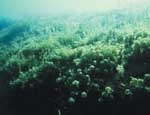PDF of this article (731 KB)








Vonda Cummings and her colleagues ventured to coastal Antarctica to learn how benthic animals get along in an icy habitat.
The coastal zone of the Ross Sea is one of the least modified on earth and, as such, offers unique opportunities to study natural ecosystems. Its integrity is potentially under threat from the increasing pressures of fishing, tourism, and climate variability and change. New Zealand has a long history of involvement in the Antarctic and plays a significant role internationally in its management. Working through the Antarctic Treaty System, New Zealand helps to conserve the continent’s intrinsic and wilderness values, set policies for environmental protection, and identify and prioritise areas for special management. Although we know a lot about the biodiversity of a few areas along the coastline (in other words, what species are there), we still have much to learn, especially about how the Antarctic marine ecosystem 'works'.
The goal of our Ross Sea research is to investigate coastal seafloor communities in order to understand their structure (what’s actually there) and function (how different species interact with each other and their habitat). We are especially interested in how the patterns we see are influenced by large-scale environmental drivers such as sea ice.
Sea ice and icebergs
A key environmental factor in the ecology of coastal Antarctica, sea-ice persistence and form vary depending on where you are along the Ross Sea coastline. For example, McMurdo Sound in the southern part of the Ross Sea is covered by a thick layer of sea ice for all but a couple of months of the year, when the sea ice usually (although not always) 'breaks out' in summer. In more northern areas, the ice covering is thinner (about 2 m), and breaks out for longer periods of time. The thicker the ice, and the more snow cover on top of the ice, the less light penetrates to the seafloor. Light is important for photosynthesis and growth of benthic (seafloor) plants, which in turn are an important food source for benthic invertebrates (such as seastars and shellfish). Some places in the coastal ocean hardly freeze at all and these areas, called polynyas, can have high biological productivity.
Another important effect of ice on benthic communities is disturbance by icebergs. They are uncommon in the McMurdo Sound area, but icebergs become increasingly prevalent as you move north, and are regularly seen drifting with strong currents along some parts of the coastline. Icebergs can scrape along the seafloor as they drift, scouring the seabed and modifying the seafloor habitat and benthic communities.
Voyage of the Italica
In February 2004, in collaboration with our Italian colleagues, we participated in the Victoria Land Transect (VLT) project onboard RV Italica. The aim of this voyage was to characterise and quantify changes in benthic communities along the Victoria Land coastline, particularly in nearshore regions where very little research has ever been conducted. Italica visited four locations in the northwest Ross Sea which span several degrees of latitude and a wide range of environmental conditions: Cape Adare, Cape Hallett, Coulman Island, and Cape Russell. These locations have varying levels of sea-ice cover, iceberg disturbance, proximity to polynyas, and biological productivity. At each location we sampled the benthic communities and habitats (for example, cobbles, sand, rock) in environments ranging from 100 to 500 m deep, using a variety of techniques, including dredge and grab sampling and video imagery.
Keys to biodiversity
Compared to our previous observations of McMurdo Sound, in these northern areas visited by Italica we noted an increasing abundance and diversity of seaweeds and biogenic habitats (that is, habitats created by living things, such as branching sponges). It became clear that several environmental variables can influence the structural and functional diversity of nearshore benthic communities in the coastal Ross Sea region. These variables include rapid changes in sea-ice conditions in the summer, frequency of iceberg disturbance, seawater temperature, and velocity of currents. The relative importance of each variable to these communities depends on the particular location along this coastline.
The voyage highlighted the importance of iceberg disturbance to the seafloor, and the need for information on the scale (both in space and time) of iceberg disturbance to help us interpret the patterns we see in seafloor diversity. However, even in areas that we suspect are prone to high levels of disturbance, our video images revealed biogenic habitats far more structurally complex than are common in temperate regions.
Our continued investigations in this region will provide basic knowledge for predicting how biodiversity and benthic-community processes are linked to productivity, and the extent to which these are structured by sea-ice dynamics. This information is essential for assessing and predicting changes to coastal biodiversity in the Antarctic, and to prioritising how we assess and respond to threats to the coastal environment.
Bergy bits
- NIWA scientists participated in an Italian-led study of Antarctic coastal ecology in the northwest Ross Sea.
- The benthic communities there must contend with low light from ice cover and disturbance by icebergs.
- We found more diverse and abundant seaweeds and biogenic habitats compared to the southern Ross Sea.
Further reading
Water & Atmosphere 11(3) is a special issue on NIWA’s research in Antarctica. These articles in that issue are particularly relevant:
- Cummings, V. (2003). Assessing biodiversity on the Antarctic sea floor. Water & Atmosphere 11(3): 10-12.
- Schwarz, A-M. (2003). Life in the dark: plant growth beneath the sea ice. Water & Atmosphere 11(3): 14-15.
- Thrush, S.F. 2003. Voyage on the Italica. Water & Atmosphere 11(3): 12.
Dayton, P.; Thrush, S. (2003). Antarctica. In: Andrew, N.; Francis, M. (eds). The living reef. The ecology of New Zealand’s rocky reefs, pp. 256-265. Craig Potton Publishing, Nelson.
Dr Vonda Cummings is a benthic ecologist whose work encompasses Antarctic and New Zealand marine coastal environments. She is based at NIWA in Wellington. This biodiversity research was funded by the Ministry of Fisheries as part of the BioRoss project.
Author contact: [email protected]
Teachers’ resource for NCEA AS: Biology 90460 (2.4), 90461 (2.5), 90716 (3.4). See other curriculum connections at www.niwa.co.nz/pubs/wa/resources
